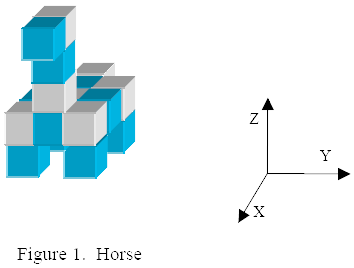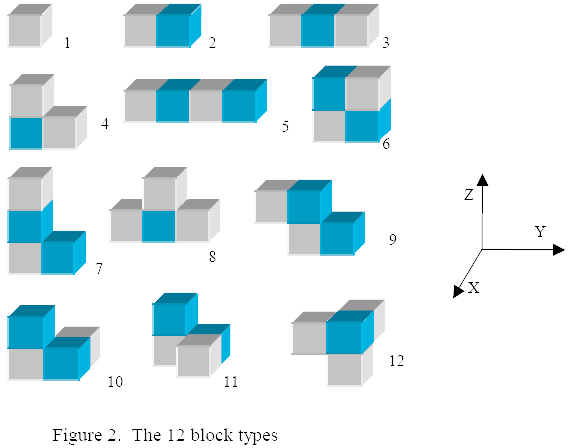IOI '00 P6 - Building with Blocks
View as PDFIOI '00 - Beijing, China
A unit cube is a cube, whose corners have integer
,
, and
coordinates. Two unit cubes are connected when they share a face. A
-dimensional solid object (solid, for short) is a non-empty connected
set of unit cubes (see Figure 1). The volume of a solid is the number of
unit cubes it contains. A block is a solid with volume at most
. Two
blocks have the same type when one can be obtained from the other by
translations and rotations (not reflections). There are exactly
block
types (see Figure 2). The colors in the figures only help to clarify the
structure of the solids; they have no other meaning.
A set of blocks is a decomposition of a solid
when the union of all
blocks in
equals
, and no two distinct blocks in
have a unit cube
in common.
Your task is to write a program that, given a description of the block
types and a solid , determines a smallest set of blocks into which
can be decomposed. It only needs to report the types of these blocks as
often as they occur in the decomposition.
Input Specification
In the input, we identify a unit cube by a line with three integers ,
, and
, being the coordinate triple of its corner that minimizes
. The input is divided into two parts, which were originally
in two separate files but have been combined out of necessity for this
online judge.
The first part of input describes the block types and will be the
same for all evaluation runs. It contains the descriptions of the
block types in Figure 2, sorted on type number. Each block type is
described by a group of consecutive lines. The first line contains the
integer
identifying the block type
. The second
line contains the volume
of the block type
. The
remaining
lines contain three integers
,
and
, each being
one unit cube of the block type
.
The second part of input describes the solid. The first line contains
the volume of the solid
. The remaining
lines
contain three integers
,
,
, each being one unit cube of the
solid
.
Output Specification
The first line must contain one integer , being the smallest number
of blocks into which the input solid can be decomposed. The second line
lists
type identifiers of the block types into which the input solid
can be decomposed. There may be several solutions for each input file,
and your program needs to output only one of them. The order of the
numbers in the second line is immaterial.
Sample Input
1
1
1 1 1
2
2
1 1 1
1 2 1
3
3
1 1 1
1 2 1
1 3 1
4
3
1 1 1
1 2 1
1 1 2
5
4
1 1 1
1 2 1
1 3 1
1 4 1
6
4
1 1 1
1 2 1
1 1 2
1 2 2
7
4
1 1 1
1 2 1
1 1 2
1 1 3
8
4
1 1 1
1 2 1
1 3 1
1 2 2
9
4
1 2 1
1 3 1
1 1 2
1 2 2
10
4
2 1 1
1 2 1
2 2 1
2 1 2
11
4
1 1 1
1 2 1
2 2 1
1 1 2
12
4
2 2 1
2 1 2
1 2 2
2 2 2
18
2 1 1
4 1 1
2 3 1
4 3 1
2 1 2
3 1 2
4 1 2
1 2 2
2 2 2
3 2 2
4 2 2
2 3 2
3 3 2
4 3 2
4 2 3
4 2 4
4 2 5
5 2 5Sample Output
5
7 10 2 10 12The solid described in the sample input is the "horse" of Figure 1.
Note that the following, as well as all of their respective permutations, are also possibilities for the second line of output:
2 7 10 11 12
2 7 11 11 12
4 4 7 10 11
4 4 9 10 11

Comments